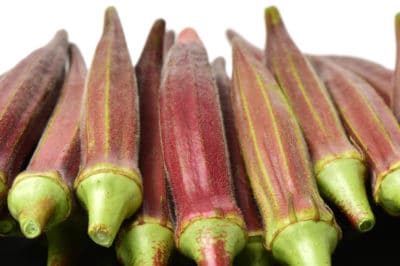Okra’s Shrouded Origins
Geobotanists believe that okra shares its geographic origin with many cultivated plants, the isolated area of Abyssinia in Eritrea, Anglo-Egyptian Sudan, and Ethiopia. Because the area had little contact with outside areas, though, the early history of how okra was developed as a crop remains unknown. Perhaps surprisingly, linguistic provides many of the clues to okra’s early migrations.
The Arabic Connection
While it might seem logical that knowledge of okra would have entered Egypt from the area of Abyssinia located in the Sudan, both the Spanish Moors of the 12th century AD and the Egyptians used a name of Arabic origin, “bamiya”, for okra rather than a name from an African language. The Egyptians still use the word “bamiya” for okra.
The Arabic words for okra are “bamya”, “bamieh”, and “bamia”. In Hebrew, the word for okra is the same as the Egyptian word, “bamiya”, while the word for okra in Greek is the Arabic word “bamia” and the Turkish word for okra is the Arabic word “bamya”.
Consequently, linguistics suggests that okra entered Arab lands by way of the Red Sea and was introduced to Egypt when it was conquered by the Arabs in the 7th century. From there, it was introduced to the eastern Mediterranean countries.
Okra Migrates Across Africa With the Bantu
The Bantu are groups of agricultural peoples who shared the Bantu language and a homeland in west central Africa along the border of Nigeria in the area of Cameroon. They also shared certain technological developments such as the ability to make ceramics and, from around 500 BCE, the ability to make iron weapons and farming implements.
The cause or causes behind the migration are unknown, although there is much speculation. The development of agriculture would have improved the Bantu’s food supply. Ceramic containers would have provided for better food storage, which would have further improved the food supply. Improved food supplies do lead to increases in population, and even if the land isn’t over populated, increases in population do lead to a need to cultivate more land.
In addition, the lands to the south and east of the Bantu were better for growing their main crops – millet and sorghum, as well as crops like bananas and yams that they had added to the list of foods that they were growing.
The peoples they encountered were hunter-gatherers, foragers, and herders. So, the Bantu not only introduced them to okra but also to agriculture, the construction of permanent shelters, the ability to make ceramics and iron tools and weapons, and the idea of a centralized government. Through the sharing of the Bantu language, they also enabled these disparate groups to communicate with each other.
The Bantu migration was a major formative event in the history of Africa, but it also resulted in the displacement of some groups and the loss of the cultures of the groups that the Bantu absorbed.
Okra and the Slave Traders
After studying the food and culture of the people they were hunting and capturing, slave traders brought foods like okra to the destinations where the slaves were sold to ease their adjustment to their new surroundings and condition. The women in the households who owned slaves learned from their slaves how to use okra in their own cooking, and some created recipes and wrote cookbooks about how to use this new vegetable.
The wide-spread effect of the slave trade is evidenced by the fact that so many languages identify okra by a name that is based on the African words for it. Among the Igbo people of southeastern Nigeria, okra is known as “ókùrù” and in the Bantu language and the languages related to Bantu okra is known by some variation of the words “(ki)ngombo”, “ngumbo”, or “gombo”.
The languages that use variations of theses words as names for okra and gumbo include:
- Portuguese – “gumbro”, “quingombo”, “quiabo”, and “quillobo”
- English – “okra” or “gumbo”
- Spanish – “gombo”, “quimbombo”, or “ocra”
- German – “ocker”
Some languages use words that reflect both the African and Arabic routes of okra’s migration. Among the French terms for okra are “gombo” and “bamie-okra”. The Italians call okra “gombo”, “ocra”, and “bammia d’egitto”. In Hungarian, the words for okra are “gombó” and bámia”.
In the case of okra’s history, okra’s origins are revealed by the origins of words.
